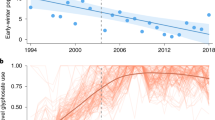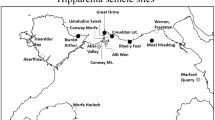Abstract
The monarch butterfly, Danaus plexippus, is one of Australia's best-known exotic butterflies, being first recorded here in the spring/summer of 1870/1871. However, the source of the original population is unknown. Using historical records we suggest that the most likely source of the founder population was from Vanuatu and/or New Caledonia. Many almost simultaneous 'first records' for the butterfly in Australia suggest that a large, well-distributed population was present when first noticed. While such a population may have developed from a limited number of individuals flying across the Coral Sea, the well documented, very dramatic appearance of large monarch populations in Australia does not appear to fit this model. Rather, we hypothesise that large numbers of monarchs were carried to Australia on cyclonic winds: no fewer that 3 cyclones hit the Queensland coast in early 1870. If one or more of these cyclones tracked from the Vanuatu/New Caledonia chain, then they may have transported monarchs. Once established on the central/northern Queensland coast, natural migration would account for the appearance of butterflies further south.
Similar content being viewed by others
References
Anonymous (1995) Riders on the storm. New Scientist 148 (Issue 2000): 13
Bailey FM (1880) On some of the introduced plants of Queensland. The Proceedings of the Linnean Society of New South Wales 4: 26-36
Bailey FM (1885) Catalogue of Plants in the Two Metropolitan Gardens, the Brisbane Botanic Garden and Bowen Park (the garden of the Queensland Acclimatisation Society). James C. Beal, Government Printer, Brisbane, Australia
Bath M and Deguara J (2002a) Tropical cyclone impacts along the Australian east coast from November to April 1858 to 2000. Retrieved from http://australiasevereweather.com/cyclones/impacts-eastcoast.htm on 30 October 2003
Bath M and Deguara J (2002b) Southern hemisphere tropical cyclones: historical tracks and data. Retrieved from http://australiasevereweather.com/cyclones/history.htm (web publication using Australian Bureau of Meteorology data) on 27 August 2003
Bentham G and Mueller F (1869) Flora Australiensis: a Description of the Plants of the Australian Territory. Reeve & Co., Covent Garden, London
Brower LP (1995) Understanding and misunderstanding the migration of the monarch butterfly (Nymphalidae) in North America: 1857-1995. Journal of the Lepidopterists' Society 49: 304-385
Dingle H, Zalucki MP and Rochester WA (1999) Seasonspecific directional movement in migratory Australian butterflies. Australian Journal of Entomology 38: 323-329
Liu C-H (1988) Analysis on the major factors causing the eruptive occurrence of the Brown Planthopper in Taiwan. Zhonghua Kunchong 8: 119-130
Liu C-H, Cheng C-H, Chen C-C, Wang S-S and Chu Y-I (1989) Immigrations of planthoppers from overseas to Taiwan in 1987. Zhonghua Kunchong 9: 1-12
MacKieth F and Summer R (1989) Millais Cuplin's Brisbane letters 1891-1892. In: Summer R (ed) Brisbane Butterflies and Beetles: The Work of Amalie Dietrich, Millais Culpin and Alfred Jefferis Turner, Brisbane History Group Sources No. 4, pp 75-138. Brisbane History Group, Brisbane, Australia
Macleay W (1877) Notes on the entomology of New Ireland. Proceedings of the Linnean Society of New South Wales 1: 301-306
Marks EN (1962) Silvester Diggles' insects. Minutes of the Ordinary Meeting of the Queensland Entomological Society, June 9th 1962, Unpublished, Queensland Entomological Society (held by the University of Queensland library)
Marks EN (1963) The first record of Danaus plexippus L. from Australia. Journal of the Entomological Society of Queensland 2: 8
Masters G (1873) Catalogue of the Described Diurnal Lepidoptera of Australia. Frederick White, Sydney
McCoy F (1873) Note on the appearance in Australia of the Danais Archippus. Annals & Magazine of Natural History (4) XI: 440-441
Miskin WH (1871) Occurrence of Danais archippus in Queensland. Entomologists Monthly Magazine 8: 17
Moskowitz D, Moskowitz J, Moskowitz S and Moskowitz H (2001) Notes on a large dragonfly and butterfly migration in New Jersey. Northeastern Naturalist 8: 483-490
Murata M, Etoh T, Itoyama K and Tojo S (1998) Sudden occurrence of the common cutworm, Spodoptera litura (Lepidoptera: Noctuidae) in southern Japan during the typhoon season. Applied Entomology & Zoology 33: 419-427
Oku T, Toki A, Koyama J and Fujimura T (1979) Further notes on the 1st generation outbreak of the Oriental Armyworm in Northern Japan 1972. Grassland Science 24: 331-336
Olliff AS (1889) Australian Butterflies: A Brief Account of the Native Families, with a Chapter on Collecting and Preserving Insects. Baston & Co. Printers, Sydney
Richardson CH and Nemeth DJ (1991) Hurricane-borne African locusts (Schistocerca graegaria) on the Windward Islands. GeoJournal 23: 349-357
Rosenberg J and Burt PJA (1999) Windborne displacements of desert locusts from Africa to the Caribbean and South America. Aerobiologia 15: 167-175
Semper G (1873) Die Wanderung von Danais erippus, Cramer, nach dem Südseeinseln, Australien und Celebes. Journal des Museum Godeffroy 1: 293-295
Shepard JM, Hughes JM and Zalucki MP (2002) Genetic differentiation between Australian and North American populations of the monarch butterfly Danaus plexippus (L.) (Lepidoptera: Nymphalidae): an exploration using allozyme electrophoresis. Biological Journal of the Linnean Society 75: 437-452
Shields AJ (1965) Australian Weather. Jacaranda Press, Melbourne
Summer R (1989) Amalie Dietrich's zoological collections for the Museum Godeffroy. In: Summer R (ed) Brisbane Butterflies and Beetles: TheWork of Amalie Dietrich, Millais Culpin and Alfred Jefferis Turner, Brisbane History Group Sources No. 4, pp 7-74. Brisbane History Group, Brisbane
Vane-Wright RI (1993) The Columbus hypothesis: an explanation for the dramatic 19th century range expansion of the monarch butterfly. In: Malcolm SB and Zalucki MP (eds) Biology and Conservation of the Monarch Butterfly, pp 179-187. Natural History Museum of Los Angeles County, Los Angeles
Walker JJ (1886) Anosia plexippus, L. (Danaus archippus, F.): a study in geographical distribution. Entomologists Monthly Magazine 22: 217-224
Walker JJ (1914) The geographical distribution of Danaida plexippus, L. (Danais erchippus, F.) with special reference to its recent migration. Entomologists Monthly Magazine 50: 181-193, 233-237
Author information
Authors and Affiliations
Corresponding author
Rights and permissions
About this article
Cite this article
Clarke, A.R., Zalucki, M.P. Monarchs in Australia: On the Winds of a Storm?. Biological Invasions 6, 123–127 (2004). https://doi.org/10.1023/B:BINV.0000010120.29634.db
Issue Date:
DOI: https://doi.org/10.1023/B:BINV.0000010120.29634.db




